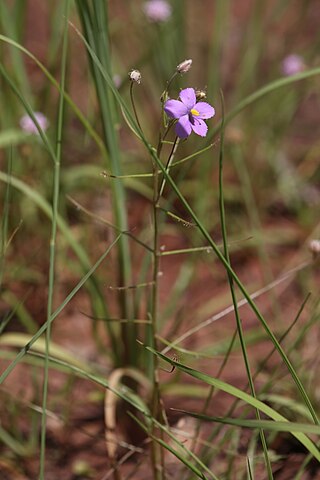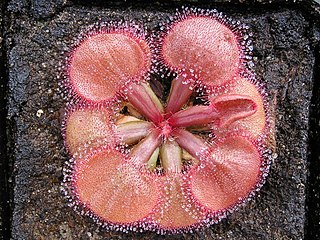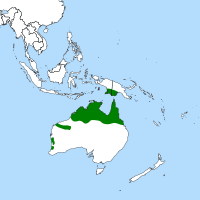
Droseraceae is a family of carnivorous flowering plants, also known as the sundew family. It consists of approximately 180 species in three extant genera. Representatives of the Droseraceae are found on all continents except Antarctica.

Drosophyllum is a genus of carnivorous plants containing the single species Drosophyllum lusitanicum, commonly known as Portuguese sundew or dewy pine. In appearance, it is similar to the related genus Drosera, and to the much more distantly related Byblis.

Roridula is a genus of evergreen, insect-trapping shrubs, with two species, of about 1⅓–2 m. It is the only genus in the family Roridulaceae. It has thin, woody, shyly branching, upright, initially brown, later grey stems, with lance- to awl-shaped leaves crowded at their tips. The star-symmetrical flowers consist from the outside in of five, green or reddish, free sepals, alternating with five white, pink or purple, free petals. Further to the middle and opposite the sepals are five stamens with the anthers initially kinked down. These suddenly flip up if the nectar-containing swelling at its base is being touched. The center of the flower is occupied by a superior ovary. The leaves and sepals carry many sticky tentacles of different sizes, that trap insects. Roridula does not break down the insect proteins, but bugs of the genus Pameridea prey on the trapped insects. These later deposit their feces on the leaves, which take up nutrients from the droppings. The species can be found in the Western Cape province of South Africa. They are commonly known as dewstick or fly bush in English and vlieëbos or vlieëbossie in Afrikaans.

Byblis aquatica is an insectivorous plant belonging to the genus Byblis, commonly known as the rainbow plants. It was described by Allen Lowrie and John Godfrey Conran in 1998, assigned to a group of annual north Australian species known as the "Byblis liniflora complex". It grows in semi-aquatic conditions and uses stalked mucilaginous glands covering its leaf surfaces to attract, catch, and digest insect prey to supplement the poor environmental nutrient supply.

A protocarnivorous plant, according to some definitions, traps and kills insects or other animals but lacks the ability to either directly digest or absorb nutrients from its prey like a carnivorous plant. The morphological adaptations such as sticky trichomes or pitfall traps of protocarnivorous plants parallel the trap structures of confirmed carnivorous plants.

Drosera ordensis is a species of sundew, native to Australia and part of the "petiolaris complex" of sundews making up the subgenus Lasiocephala. Compared to many petiolaris sundews, it has wide petioles, which are densely covered in silvery hairs. It usually forms rosettes 8 cm across, although plants up to 20 cm in diameter have been reported.
Genlisea margaretae is a carnivorous species in the genus Genlisea native to areas of Madagascar, Tanzania, and Zambia. It has pale bundles of root-like organs up to about 20 cm long under ground that attract, trap, and digest protozoans. These organs are subterranean leaves, which lack chlorophyll. It had been known to possess the smallest known genome of any flowering plant as of 2006, but was later surpassed by the related species Genlisea tuberosa.

Byblis gigantea, commonly known as rainbow plant, is a carnivorous species of plant in the Byblidaceae family. It is endemic to Australia.

Byblis liniflora is a species of carnivorous plant in the family Byblidaceae. It is found in Australia, Indonesia, and Papua New Guinea.

Byblis rorida is a species of carnivorous plant in the Byblidaceae family. It is endemic to Australia.
Stylidium diceratum is a dicotyledonous plant that belongs to the genus Stylidium. The specific epithet diceratum is Greek for "two horns", referring to the two appendages that are present on the bend of the gynostemium. It is an annual plant that grows from 15 to 35 cm tall. The longer leaves are lanceolate and the shorter ones are spathulate, forming a basal rosettes around the stem. The leaves are around 5–8 mm long and 0.2-2.5 mm wide. Inflorescences are around 6–15 cm long and produce flowers that are orange with dark orange and pink veins and bloom from June to August in their native range. S. diceratum is only known from the type location, which is at creek crossings on the road to Beverley Springs in the Kimberley region of Western Australia. Its habitat is recorded as being sandy soils on creek margins. It grows in the presence of S. ceratophorum, S. rubriscapum, Drosera caduca, D. paradoxa, Byblis liniflora, and Grevillea pteridifolia. S. diceratum is most closely related to S. longicornu, but it can be confused with S. ceratophorum, which also has an orange corolla but twice as large.

Byblis lamellata is a carnivorous plant in the Byblidaceae family. It is endemic to Australia.
Byblis guehoi is a species of carnivorous plant in the genus Byblis. It is a compact species and is tetraploid. It was described in 2008 by Allen Lowrie and John Godfrey Conran. It is endemic to the Kimberley region of Western Australia.

Carnivorous plants are plants that derive some or most of their nutrients from trapping and consuming animals or protozoans, typically insects and other arthropods, and occasionally small mammals and birds. They still generate all of their energy from photosynthesis. They have adapted to grow in waterlogged sunny places where the soil is thin or poor in nutrients, especially nitrogen, such as acidic bogs. They can be found on all continents except Antarctica, as well as many Pacific islands. In 1875, Charles Darwin published Insectivorous Plants, the first treatise to recognize the significance of carnivory in plants, describing years of painstaking research.

Drosera falconeri is a carnivorous plant in the family of Droseraceae. It is endemic to the Northern Territory of Australia.

Pinguicula, commonly known as butterworts, is a genus of carnivorous flowering plants in the family Lentibulariaceae. They use sticky, glandular leaves to lure, trap, and digest insects in order to supplement the poor mineral nutrition they obtain from the environment. Of the roughly 80 currently known species, 13 are native to Europe, 9 to North America, and some to northern Asia. The largest number of species is in South and Central America.

Australia has one of the world's richest carnivorous plant floras, with around 187 recognised species from 6 genera.

The Australian pitcher plant, also known as Albany pitcher plant, is the only species of plant in the Cephalotaceae family and Oxalidales order. It can be found exclusively in moist conditions in a small region in southwest Australia and is considered to be a carnivorous plant. Similar to the not related Nepenthes, it catches its victims with pitfall traps.

Byblis pilbarana is a carnivorous species of plant in the family Byblidaceae. It is found in Western Australia.



















